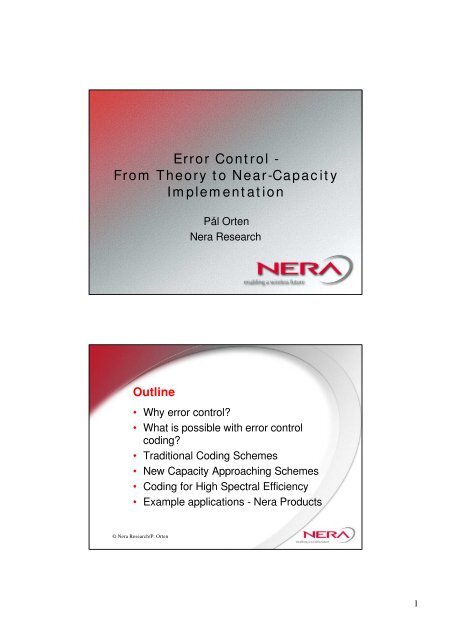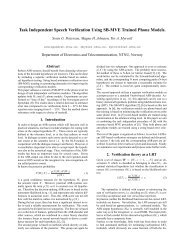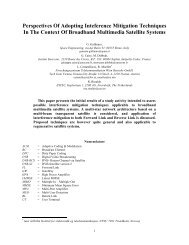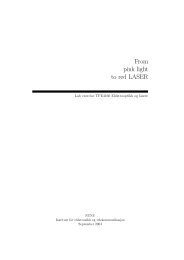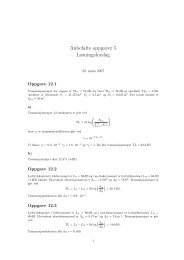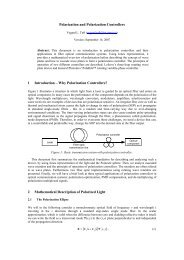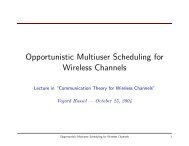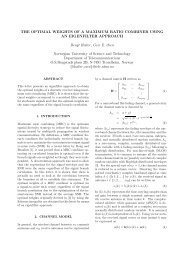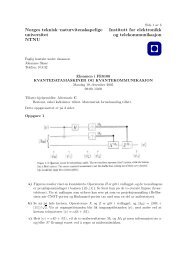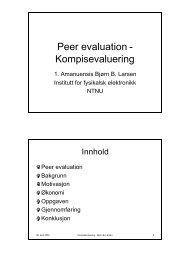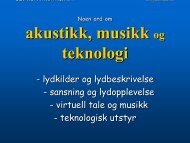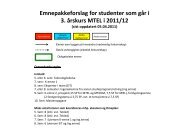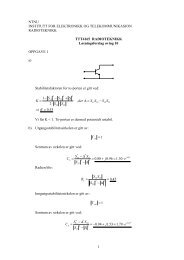Error Control - From Theory to Near-Capacity Implementation
Error Control - From Theory to Near-Capacity Implementation
Error Control - From Theory to Near-Capacity Implementation
You also want an ePaper? Increase the reach of your titles
YUMPU automatically turns print PDFs into web optimized ePapers that Google loves.
<strong>Error</strong> <strong>Control</strong> -<br />
<strong>From</strong> <strong>Theory</strong> <strong>to</strong> <strong>Near</strong>-<strong>Capacity</strong><br />
<strong>Implementation</strong><br />
Pål Orten<br />
Nera Research<br />
Outline<br />
• Why error control?<br />
• What is possible with error control<br />
coding?<br />
• Traditional Coding Schemes<br />
• New <strong>Capacity</strong> Approaching Schemes<br />
• Coding for High Spectral Efficiency<br />
• Example applications - Nera Products<br />
© Nera Research/P. Orten<br />
1
Why <strong>Error</strong> <strong>Control</strong> Coding<br />
Transmitter<br />
Channel<br />
Receiver<br />
• Thermal noise<br />
• Channel: Fading and inter-symbol interference<br />
• Interference: from system itself and other<br />
systems<br />
• May be combated by channel coding (there are<br />
other ways also)<br />
© Nera Research/P. Orten<br />
Interference<br />
Noise<br />
Principle of error control<br />
• Add redundancy <strong>to</strong> enable<br />
– <strong>Error</strong> detection<br />
– <strong>Error</strong> correction<br />
– or both<br />
• d min =10, correct 4 errors, detect d min -1 errors<br />
C1<br />
d min<br />
C2<br />
© Nera Research/P. Orten<br />
2
Some <strong>Theory</strong><br />
© Nera Research/P. Orten<br />
Shannon Limit<br />
⎛ S ⎞<br />
C = W ⎜1<br />
+ ⎟<br />
⎝ N ⎠<br />
⇔<br />
E<br />
N<br />
b<br />
0<br />
log 2<br />
C<br />
( 2 1)<br />
/ W<br />
−<br />
=<br />
W<br />
C<br />
W → ∞ ⇒ E<br />
/ N0 → −1.6 dB<br />
No limit on input, AWGN channel<br />
b<br />
© Nera Research/P. Orten<br />
3
W/C<br />
8<br />
6<br />
4<br />
2<br />
W/C versus E b /N 0<br />
Shannon Limit<br />
Asymp<strong>to</strong>te -1.6 dB<br />
0<br />
-2 0 2 4 6<br />
© Nera Research/P. Orten E b<br />
/N 0<br />
[dB]<br />
• No limit on<br />
input<br />
• AWGN<br />
channel<br />
• To reach the<br />
limit:<br />
– infinite<br />
bandwidth<br />
– infinite code<br />
word length<br />
I praksis?<br />
• For praktiske systemer:<br />
– koderate R c > 0<br />
– begrensninger på input (gitt av modulasjon)<br />
– endelig kodeordslengde<br />
⇒<br />
-1.6 dB grensen vil ikke nås<br />
• Praktisk grense for<br />
© Nera Research/P. Orten<br />
– koderate eller bit/s/Hz<br />
– modulasjonsformat<br />
– kodeordslengde<br />
4
Effect of Coding<br />
© Nera Research/P. Orten<br />
E b /N 0<br />
<strong>Capacity</strong> for given Code Rate<br />
C<br />
=<br />
1<br />
2<br />
log<br />
2<br />
(1 +<br />
2RcE<br />
N<br />
0<br />
b<br />
)<br />
R<br />
c<br />
© Nera Research/P. Orten<br />
C<br />
≤<br />
1−<br />
H ( e)<br />
b<br />
Find (P b , E b /N 0 ) pair<br />
⇒<br />
<strong>From</strong> the converse<br />
<strong>to</strong> the coding theorem<br />
Limit for given code rate<br />
5
<strong>Capacity</strong> for different code rates<br />
10 0 E b<br />
/N 0<br />
[dB]<br />
BER<br />
10 -2<br />
R c =0.75<br />
R c<br />
=0.5<br />
R c =0.33<br />
R c =0.1<br />
Unconstrained<br />
AWGN<br />
Channel<br />
10 -4<br />
10 -6<br />
-2 -1 0 1 2<br />
© Nera Research/P. Orten<br />
<strong>Capacity</strong> as function of code<br />
rate - binary input (1)<br />
Example: Binary-input (+/- A), AWGN channel<br />
∞<br />
1<br />
p(<br />
y | A)<br />
1<br />
p(<br />
y | −A)<br />
C =<br />
∫<br />
p(<br />
y | A) log<br />
2<br />
dy +<br />
∫<br />
p(<br />
y | −A) log<br />
2<br />
dy<br />
2<br />
p(<br />
y)<br />
2<br />
p(<br />
y)<br />
−∞<br />
∞<br />
−∞<br />
Constrained<br />
AWGN Channel,<br />
(<strong>From</strong> Proakis)<br />
© Nera Research/P. Orten<br />
6
<strong>Capacity</strong> as function of code<br />
rate - binary input (2)<br />
Code Rate<br />
1<br />
0.9<br />
0.8<br />
0.7<br />
0.6<br />
0.5<br />
0.4<br />
0.3<br />
Unconstrained Input<br />
Binary Input<br />
© Nera Research/P. Orten<br />
0.2<br />
-1 0 1 2 3 4 5 6<br />
<strong>Capacity</strong> Limit E /N [dB] b 0<br />
Theoretical limit for given<br />
spectral efficiency<br />
•Limited bandwidth, W<br />
•Data rate R (bits/s)<br />
•Shannons capasity can be expressed as:<br />
R<br />
η =<br />
W<br />
© Nera Research/P. Orten<br />
E b<br />
N<br />
0<br />
η<br />
2 −1<br />
≥<br />
η<br />
is spektral-efficiency in bit/s/Hz<br />
7
Theoretical limit for given<br />
spectral efficiency (plot)<br />
Spectral Effeciency [bit/s/Hz]<br />
5<br />
4<br />
3<br />
2<br />
1<br />
0<br />
-2 0 2 4 6 8<br />
<strong>Capacity</strong> Limit E /N (dB) b 0<br />
© Nera Research/P. Orten<br />
Unconstrained<br />
AWGN<br />
Channel<br />
Larger Modulation Alphabets-<br />
Higher Spectral Efficiency<br />
<strong>Capacity</strong> Limit E b<br />
/N 0<br />
(dB)<br />
10<br />
8<br />
6<br />
4<br />
2<br />
0<br />
QPSK<br />
16-QAM<br />
64-QAM<br />
Constrained<br />
Additive Gaussian<br />
Channel<br />
0.3 0.4 0.5 0.6 0.7 0.8 0.9<br />
Code Rate<br />
© Nera Research/P. Orten<br />
8
<strong>Capacity</strong> as function of<br />
spectral efficiency<br />
Spectral Effeciency [bit/s/Hz]<br />
6<br />
5<br />
4<br />
3<br />
2<br />
1<br />
0<br />
-2 0 2 4 6 8 10<br />
<strong>Capacity</strong> Limit E /N (dB) b 0<br />
© Nera Research/P. Orten<br />
Unconstrained<br />
QPSK<br />
16-QAM<br />
64-QAM<br />
Constrained<br />
Additive Gaussian<br />
Channel<br />
Calculation:<br />
η = log 2 (M)*R c<br />
<strong>Capacity</strong> Limit E b<br />
/N 0<br />
(dB)<br />
<strong>Capacity</strong> as function of<br />
Packet Length<br />
Based on paper:<br />
3<br />
2<br />
1<br />
0<br />
-1<br />
R c<br />
=0.1<br />
R c<br />
=0.33<br />
R c<br />
=0.5<br />
R c<br />
=0.75<br />
10 2 10 3 10 4 10 5 10 6<br />
Block length N information bits<br />
© Nera Research/P. Orten<br />
Code Performance as<br />
Function of Block<br />
Size, av Dolinar,<br />
Divsalar & Simon<br />
Expression given as<br />
function of N, R c and<br />
P w (Word <strong>Error</strong><br />
Probability)<br />
9
Traditional Coding Schemes<br />
© Nera Research/P. Orten<br />
Basic Terms<br />
• Code rate<br />
k<br />
R = =<br />
n<br />
• Soft Decisions<br />
# Information<br />
# Code<br />
word<br />
symbols<br />
symbols<br />
– Principle idea (more or less correct/wrong)<br />
– Erasures decoding (3 level soft decision - very simple)<br />
– 8 level soft decision - often used in many coding<br />
schemes<br />
– Soft decision gain: ca 2 dB for AWGN channels<br />
– Typically 7-9 dB possible for fading channels<br />
© Nera Research/P. Orten<br />
10
Traditional Coding Schemes<br />
●<br />
Block Codes<br />
– Long Codes<br />
●<br />
Convolutional Codes<br />
– Short Codes<br />
– Hard desisjon<br />
– Soft desisjon (Viterbi)<br />
– Good at low bit error<br />
rates (10 -4 and down)<br />
– Good at high bit-error<br />
rates (10 -3 - 10 -4 )<br />
– Many types<br />
• Ex. Hamming, Golay,<br />
Reed-Muller, Reed<br />
Solomon, BCH, etc<br />
– Used for instance in CD<br />
players (RS), Intelsat<br />
(RS), Voyager (Golay)<br />
– Used in Inmarsat, 3G and<br />
various wireless systems<br />
– Long constraint length<br />
codes with sequential<br />
decoding<br />
© Nera Research/P. Orten<br />
Basic Block Code<br />
• Operates on one block at a time<br />
c = mG<br />
• Algebraic decoding (often)<br />
• Soft decision decoding - high complexity<br />
• Typically good performance at high code<br />
rates<br />
© Nera Research/P. Orten<br />
11
Performance Golay Code<br />
• Extended Golay<br />
Code (24,12)<br />
• Hard decision<br />
• Erasure decoding<br />
• Soft decoding using<br />
Chase algorithm<br />
• Used in WLL<br />
• Low complexity<br />
decoding<br />
© Nera Research/P. Orten<br />
Convolutional Codes<br />
– Described by trellis<br />
– Maximum Likelihood Decoding (ML) by Viterbi<br />
algorithm<br />
– Soft Decision decoding easily implemented<br />
– Used in very many applications, Deep Space, SatCom,<br />
various wireless systems like 3G<br />
– Rate 1/(n+1) encoder:<br />
1<br />
2<br />
3<br />
K-2 K-1 K<br />
g 0<br />
© Nera Research/P. Orten<br />
g n<br />
12
Convolutional Code - BER<br />
• K=7 Feed<br />
Forward Code<br />
• MFD (and ODS)<br />
• Viterbi Decoding<br />
• Rate 3/4<br />
obtained by<br />
puncturing rate<br />
1/2<br />
BER<br />
BER<br />
10 0 1/2-rate<br />
3/4-rate<br />
10 -2<br />
10 -4<br />
10 -6<br />
10 -8<br />
0 1 2 3 4 5 6<br />
EbNo (dB)<br />
© Nera Research/P. Orten<br />
E b /N 0<br />
Foldningskode - Tap<br />
Koderate<br />
Yting ved Kapasitet<br />
10 -6 Constrained<br />
Binary Input<br />
Tap pga<br />
avgrensa<br />
blokklengde<br />
½ 5.0 0.2 ?? 4.8<br />
¾ 6.0 1.6 ?? 4.4<br />
Tap til<br />
Constrained<br />
input<br />
Grense<br />
•Implementert i ASIC<br />
•Relativt s<strong>to</strong>rt tap til kapasitetsgrensa<br />
•Blokklengde - vanskelig å definere<br />
© Nera Research/P. Orten<br />
13
Concatenated Coding<br />
RS<br />
encoder<br />
Convolutional<br />
Encoder<br />
Viterbi<br />
Decoder<br />
RS<br />
decoder<br />
• Traditional scheme for very low error rate<br />
• Typically RS + Convolutional<br />
• Viterbi - soft decisions<br />
• RS burst error correction<br />
• Viterbi gives moderate BER where RS<br />
takes over and brings it further down<br />
• Long Code with practical complexity<br />
© Nera Research/P. Orten<br />
Alternative <strong>to</strong> Concatenation<br />
• Use a very long<br />
constraint length (K)<br />
convolutional code<br />
• Typically - K=30-50<br />
• <strong>Error</strong> rate decreases<br />
exponentially with<br />
constraint length<br />
• Viterbi decoding:<br />
– 2 30 ~ 10 9 states<br />
• NOT IMPLEMENTABLE<br />
• Solution: Sequential<br />
Decoding<br />
– Limited but smart<br />
search<br />
– Search the most likely<br />
paths<br />
– Complexity depends<br />
on channel conditions<br />
– Can calculate<br />
conditions for when<br />
decoding is possible<br />
© Nera Research/P. Orten<br />
14
Sekvensiell dekoding<br />
Koderate<br />
Pare<strong>to</strong><br />
eksponent<br />
lik 1 ved:<br />
Kapasitet<br />
Constrained<br />
Binary Input<br />
Tap pga<br />
avgrensa<br />
blokklengde<br />
Tap til<br />
Constrained<br />
Grense<br />
½ 2.2 dB 0.2 dB ?? 2 dB<br />
¾ 3.7 dB 1.6 dB ?? 2.1 dB<br />
• K=36, R=1/2 Implementert i DSP<br />
• Problem: Overflyt i buffere<br />
© Nera Research/P. Orten<br />
© Nera Research/P. Orten<br />
Eksempel frå Nera Produkt<br />
• Inmarsat M&B<br />
– Foldningskode K=7 (1/2 og 3/4-rate)<br />
– Sekvensiell dekoding K=36 (1/2 rate)<br />
• Nera World Communica<strong>to</strong>r<br />
– Turbo 1/2-rate med 16-QAM<br />
• DVB-RCS<br />
– Foldningskode og Reed-Solomon (255,239,8)<br />
– Turbo<br />
•BGAN (next generation mobile terminals)<br />
– Turbo 16 tilstander<br />
15
New iterative capacity<br />
approaching schemes<br />
© Nera Research/P. Orten<br />
Turbo Codes<br />
ICC 1993 - Presentation of Turbo Codes<br />
- a huge step <strong>to</strong>wards the Shannon limit<br />
• Convolutional Turbo:<br />
– Parallel Concatenated<br />
Convolutional (PCC) codes<br />
– Serially Concatenated<br />
Convolutional (SCC) Codes<br />
– Separated by interleaver<br />
– Soft in and soft out, iterative<br />
decoding<br />
• Block based Turbo:<br />
– Turbo Product Codes<br />
(TPC)<br />
– PA-Codes<br />
– LDPC Codes<br />
– Soft decision, iterative<br />
decoding<br />
Long codes, soft decision, iterative decoding<br />
© Nera Research/P. Orten<br />
16
PCC Turbo Principle<br />
• Encoder<br />
– Recursive convolutional<br />
encoders<br />
– Interleaver essential<br />
X m<br />
• Decoder<br />
– Soft in soft out<br />
– Many iterations<br />
Xd<br />
KODER<br />
I<br />
X s<br />
Ys<br />
Y m<br />
DEKODER<br />
I<br />
Le<br />
(Soft info)<br />
INTER-<br />
LEAVER<br />
INTER-<br />
LEAVER<br />
DEINTER-<br />
LEAVER<br />
KODER<br />
II<br />
Zs<br />
Zm<br />
DEKODER<br />
II<br />
L e<br />
(Soft info)<br />
X'd<br />
© Nera Research/P. Orten<br />
PCC codes - properties<br />
© Nera Research/P. Orten<br />
– The ”original” Turbo code as presented by<br />
Berrou in 1993<br />
– Good overall performance, also at 10 -3<br />
– Good convergence of iterative decoder (few<br />
iterations necessary)<br />
– Possible candidates:<br />
• BGAN (16-states)<br />
• UMTS (8-states)<br />
• DVB-RCS (8-states, duo-binary)<br />
– The above codes must be punctured <strong>to</strong> get<br />
high rate => affects BER performance<br />
17
Performance Example<br />
BER<br />
10 -1 <strong>Capacity</strong> Limit<br />
Uncoded<br />
10 -2<br />
Sequential limit<br />
Convolutional Coding<br />
Concatenated Coding<br />
DVB-RCS Turbo<br />
10 -3<br />
10 -4<br />
Convolutional<br />
• MPEG block<br />
lengths (188<br />
bytes)<br />
• R=1/2<br />
10 -5<br />
10 -6<br />
Turbo<br />
Concatenated<br />
RS+Convolutional<br />
10 -7<br />
0 2 4 6 8 10 12 14<br />
© Nera Research/P. Orten<br />
E b /N 0<br />
Code Rate<br />
DVB-RCS<br />
1<br />
0.9<br />
0.8<br />
0.7<br />
0.6<br />
0.5<br />
0.4<br />
0.3<br />
-1 0 1 2 3 4 5 6<br />
Required E b /N 0<br />
Code Performance Comparison for MPEG (1 packet) and PER=10 -5<br />
© Nera Research/P. Orten<br />
Required Eb/No <strong>to</strong> get 1e-5 (MPEG)<br />
<strong>Capacity</strong> Binary Input<br />
<strong>Capacity</strong> MPEG Block<br />
Turbo Codes<br />
Concatenated Codes<br />
18
Iterative decoding - Block Codes<br />
• Turbo Product Codes (TPC)<br />
• Product Accumulate Codes<br />
• Low Density Parity Check Codes (LDPC)<br />
• Nera: Theoretical Studies and Simulations<br />
• Interesting because:<br />
© Nera Research/P. Orten<br />
– Typically better than convolutional based Turbo<br />
codes at high code rates<br />
– Fewer patents<br />
– TPC included in IEEE802.16 standard<br />
– PA codes - low complexity<br />
– LDPC has “World Record” 0.05 dB from Shannon<br />
– Complexity -> high-capacity systems<br />
Turbo Product Codes (TPC)<br />
• Two (or more) block codes<br />
concatenated<br />
• Soft in soft out, iterative decoding<br />
• Component codes - e.g. BCH<br />
d 11<br />
d 12<br />
d 13<br />
d 14<br />
d 15<br />
p 16<br />
p 17<br />
d 21<br />
d 22<br />
d 23<br />
d 24<br />
d 25<br />
p 26<br />
p 27<br />
d 31 d 32<br />
d 33<br />
d 34<br />
d 35<br />
p 36<br />
p 37<br />
p 41 p 42<br />
p 43<br />
p 44<br />
p 45<br />
p 46 p 47<br />
© Nera Research/P. Orten<br />
19
Ytelse TPC<br />
• Simulert med AWGN, QPSK and 16QAM<br />
• Ytelse ved 10 -5 BER<br />
(TPC)<br />
Koderate<br />
Ytelse ved Kapasitet<br />
10 -5 Constrained<br />
Binary Input<br />
Blokklengde<br />
(kodet)<br />
Ekstra tap<br />
Blokklengde<br />
Tap til<br />
Praktisk<br />
Grense<br />
0.66 3.0 dB 1.2 dB 1024 (32x32) 1.0 dB 0.8 dB<br />
0.79 3.3 dB 2.0 dB 4096 (64x64) 0.5 dB 0.8 dB<br />
16-QAM<br />
0.79 6.8 dB 5.1 dB 4096 (64x64) 0.5 dB 1.3 dB<br />
© Nera Research/P. Orten<br />
TPC Performance vs TCM<br />
TCM and TPC with 64 QAM, comparable<br />
spectral efficiency ((64,57) TPC code)<br />
BER<br />
10 -2 <strong>Capacity</strong> Limit<br />
TPC and 64QAM<br />
64-TCM<br />
10 -4<br />
10 -6<br />
• Good at high code<br />
rates<br />
• Interesting for radio<br />
link systems<br />
• In IEEE802.16<br />
standard<br />
10 -8<br />
4 6 8 10 12 14 16 18<br />
© Nera Research/P. Orten<br />
E b /N 0<br />
20
Product Accumulate Codes<br />
PA-I<br />
SPC<br />
π 1<br />
π 2<br />
+<br />
T<br />
SPC<br />
PA-II<br />
TPC<br />
TPC<br />
TPC<br />
/SPC<br />
/SPC<br />
/SPC<br />
π 2<br />
+<br />
T<br />
© Nera Research/P. Orten<br />
PA code -properties<br />
– A new low complexity scheme, presented in<br />
2001<br />
– PA-codes have good overall performance<br />
– No puncturing, assumed <strong>to</strong> have better<br />
performance at low BER<br />
– Few/no patents<br />
– Slower convergence than PCC<br />
• PA-I<br />
• PA-II<br />
• Generalised PA- codes (for lower rates)<br />
© Nera Research/P. Orten<br />
21
Low Density Parity Check<br />
(LDPC) Codes<br />
• Block Code<br />
• Iterative decoding<br />
c=mG GH T =0<br />
1 1<br />
1<br />
1<br />
© Nera Research/P. Orten 1<br />
1<br />
H<br />
1<br />
1<br />
1<br />
1<br />
LDPC codes -properties<br />
– Proposed by Gallager i 1963<br />
– Good performance, especially for high code<br />
rates and long block lengths<br />
– 0.005 dB from Shannon limit!!<br />
– Low decoder complexity<br />
– Few (no?) patents<br />
– Disadvantages:<br />
• Some error flattening for some codes<br />
• Not ready for implementation, much ongoing<br />
research<br />
© Nera Research/P. Orten<br />
22
Ytelse - LDPC koder<br />
• Simulert ytelse, BPSK/QPSK, AWGN<br />
• ATM og MPEG blokker<br />
• Regulære LDPC koder, BER=10 -5<br />
(LDPC)<br />
Koderate<br />
Ytelse ved Kapasitet<br />
10 -5 Constrained<br />
Binary Input<br />
Blokklengde<br />
(kodet)<br />
Ekstra tap<br />
Blokklengde<br />
Tap til<br />
Praktisk<br />
Grense<br />
1/2 1.8 dB 0.2 dB 1504 MPEG 0.7 dB 0.9 dB<br />
4/5 3.7 dB 1.6 dB 1504 MPEG 0.7 dB 1.4 dB<br />
1/2 2.8 dB 0.2 dB 424 ATM 1.2 dB 1.4 dB<br />
4/5 4.5 dB 1.6 dB 424 ATM 1.2 dB 1.7 dB<br />
© Nera Research/P. Orten<br />
Performance Example LDPC Codes<br />
Spectral<br />
Efficiency<br />
1<br />
0.8<br />
0.6<br />
0.4<br />
•PER=10 -5<br />
• BER=10 -5<br />
for LDPC<br />
• MPEG packets<br />
<strong>Capacity</strong><br />
0.2<br />
Concatenated<br />
PCC<br />
TPC<br />
LDPC<br />
0<br />
-1 0 1 2 3 4 5 6 7<br />
© Nera Research/P. Orten<br />
Required E b /N 0<br />
23
Mapping <strong>to</strong> higher order<br />
constellations<br />
TCM<br />
x n<br />
x m+1<br />
n<br />
: :<br />
n-m<br />
: :<br />
MAPPING<br />
Select signal<br />
from subset<br />
a i<br />
xm<br />
x1<br />
: :<br />
Convolutional<br />
Encoder<br />
Rate m/(m+1)<br />
z m<br />
: :<br />
z1<br />
Select<br />
Subset<br />
z0<br />
• Optimised mapping necessary in order <strong>to</strong><br />
achieve coding gain<br />
• Effective “block length” of code is short<br />
© Nera Research/P. Orten<br />
Mapping <strong>to</strong> higher order<br />
constellations<br />
Turbo-TCM<br />
/ TCM<br />
x 1<br />
Turbo-TCM / TCM<br />
Encoder <strong>to</strong>gether with<br />
optimised mapping<br />
ai<br />
Encoder +<br />
Gray mapping<br />
© Nera Research/P. Orten<br />
MAPPING<br />
x1 y 1<br />
Turbo<br />
Simple<br />
Encoder<br />
Gray<br />
Mapping<br />
ai<br />
24
Mapping<br />
• Turbo + Gray mapping works well,<br />
because<br />
© Nera Research/P. Orten<br />
– Code is long and give good coding gain<br />
anyway<br />
– Distance properties of individual symbols in<br />
the code is less important<br />
– Also more flexible with respect <strong>to</strong><br />
• Modulation schemes<br />
• Code rate<br />
– Confirmed by several papers<br />
Code Comparison<br />
• Block lengths K=1000 and 4000<br />
– With 2.5*N <strong>to</strong>tal delay16µs and 64 µs<br />
• Modulation/Code rate Schemes<br />
• 64-QAM Code rate ≈ 0.85<br />
• 128-QAM Code rate ≈0.93<br />
© Nera Research/P. Orten<br />
25
BER Performance 64-QAM<br />
Short Delay (K=1000)<br />
© Nera Research/P. Orten<br />
BER Performance 64-QAM<br />
Long Delay (K=4000)<br />
© Nera Research/P. Orten<br />
26
Evaluation of Iterative Decoding<br />
BER<br />
BER<br />
Flattening<br />
is possible Bad implemena<strong>to</strong>n of<br />
iterative algorithm<br />
Given by<br />
minimum distance<br />
of code<br />
Eb/N 0<br />
© Nera Research/P. Orten<br />
1000<br />
Decoding Complexity of Coding<br />
Schemes<br />
900<br />
800<br />
700<br />
600<br />
500<br />
400<br />
300<br />
200<br />
100<br />
0<br />
LDPC (tree) PCC-BGAN PCC-UMTS PA-I PA-II PA-II (tree) TCM<br />
R=0.84 R=0.93<br />
Complexity of coding schemes in # of max-log or min-sum operations pr decoded bit<br />
© Nera Research/P. Orten<br />
27
Conclusion<br />
• For practical systems we can not achieve<br />
the -1.6 dB limit<br />
• “Practical limit” - depend on rate,<br />
constellation, block length<br />
• New techniques with iterative decoding<br />
approach capacity<br />
• For High Data Rates - Complexity is a<br />
consern<br />
• Mapping not critical for long codes<br />
© Nera Research/P. Orten<br />
28


